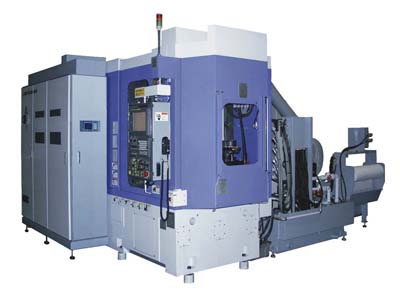
Mitsubishi Heavy Industries Ltd. (MHI) has developed technology enabling high-speed and high-precision machining of a diverse range of precision gears, which are used in vehicle transmission systems and other applications, by a single machine, thereby permitting the complete grinding process, through to finishing, to be achieved at low cost.
By applying two different multi-threaded grinding wheels according to the specific machining task — a proprietary technology — the company's innovative new system enables mass production of gears requiring difficult machining, including internal ring gears as well as some external gears such as stepped gears and pinion gears with shafts. Through aggressive proposal-based marketing, the company looks to capture expanding global demand for quieter gears and for more compact and lighter gear mechanisms.
MHI developed its new grinding technology aiming to significantly expand the application fields of the company's "ZI20A," an epoch-making high-performance grinding machine for internal ring gears introduced in 2009. To realize external gear machining by the ZI20A, the company adopted an hourglass-shaped, multi-threaded grinding wheel that was developed specifically for this purpose. Stepped gears, which have gears of different diameters layered in a staircase pattern, and pinion gears with shafts are machinable thanks to the prevention of interference between grinding wheels and workpieces.
For grinding of internal ring gears, which are typically used as planetary gears, the machine conversely uses a barrel-shaped, multi-threaded grinding wheel. The grinding wheel enables high-speed and high-precision finish machining by preventing possible interference between the grinding wheel and the workpiece, as in the grinding of external gears.
For finish grinding of internal ring gears, external stepped gears and gears with shafts after heat processing, conventionally a method for grinding tooth grooves one by one using a small-diameter disk-shaped grinding wheel has mainly been used to prevent interference — a procedure that erodes mass production merits and impedes cost reduction efforts. In contrast, in lieu of a disk-shaped grinding wheel the ZI20A uses a multi-threaded grinding wheel capable of multi-tooth groove grinding simultaneously.
Featuring a high rotation speed of 15,000 revolutions per minutes (rpm) for the main spindle and 6,000 rpm for the workpiece spindle, the ZI20A enables a 75 percent reduction in grinding time compared with conventional machines, while still maintaining high accuracy. MHI has already received orders for two units of the ZI20A incorporating the new technology; deliveries are scheduled for completion before year's end.
Contact Details
Related Glossary Terms
- grinding
grinding
Machining operation in which material is removed from the workpiece by a powered abrasive wheel, stone, belt, paste, sheet, compound, slurry, etc. Takes various forms: surface grinding (creates flat and/or squared surfaces); cylindrical grinding (for external cylindrical and tapered shapes, fillets, undercuts, etc.); centerless grinding; chamfering; thread and form grinding; tool and cutter grinding; offhand grinding; lapping and polishing (grinding with extremely fine grits to create ultrasmooth surfaces); honing; and disc grinding.
- grinding machine
grinding machine
Powers a grinding wheel or other abrasive tool for the purpose of removing metal and finishing workpieces to close tolerances. Provides smooth, square, parallel and accurate workpiece surfaces. When ultrasmooth surfaces and finishes on the order of microns are required, lapping and honing machines (precision grinders that run abrasives with extremely fine, uniform grits) are used. In its “finishing” role, the grinder is perhaps the most widely used machine tool. Various styles are available: bench and pedestal grinders for sharpening lathe bits and drills; surface grinders for producing square, parallel, smooth and accurate parts; cylindrical and centerless grinders; center-hole grinders; form grinders; facemill and endmill grinders; gear-cutting grinders; jig grinders; abrasive belt (backstand, swing-frame, belt-roll) grinders; tool and cutter grinders for sharpening and resharpening cutting tools; carbide grinders; hand-held die grinders; and abrasive cutoff saws.
- grinding wheel
grinding wheel
Wheel formed from abrasive material mixed in a suitable matrix. Takes a variety of shapes but falls into two basic categories: one that cuts on its periphery, as in reciprocating grinding, and one that cuts on its side or face, as in tool and cutter grinding.






